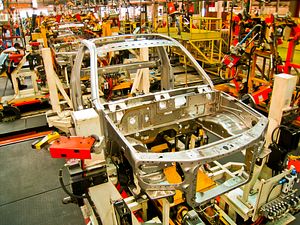Despite the veneer of smiles and handshakes at last month’s APEC summit, Beijing has recently taken a confrontational approach toward foreign investors. In response, a number of foreign companies have shifted their production facilities to Southeast Asia. The move could spark an investment boom in Vietnam, which has received myriad major projects from companies worldwide, underscoring the country’s vast potential as a foreign investment destination.
In recent months, Chinese authorities have levied multimillion-dollar fines against Western firms, sometimes on the flimsiest of justifications. Automakers Volkswagen and Chrysler, Korea’s electronics giant Samsung, and American multinationals GlaxoSmithKline and Johnson & Johnson were slapped with huge fines for what China called monopolistic behavior. Microsoft, Qualcomm and Daimler-Benz remain under investigation.
Such charges sound like backdoor protectionism in an open market where dozens of car makers or household goods producers compete for consumers and where competition is cut-throat. It may not be a coincidence that these fines are applied to industries in which China has plans to create its own products but has failed to make significant inroads, such as high-end cars and computers.
Enforcement of business regulations is often left to local officials who lack the experience and training necessary for a complex investigation of multinational corporations. Yet they end up hauling away reams of confidential company data. Huge fines are announced sometimes only a few weeks after the raid, while the companies in question have little opportunity to respond to the charges.
In response to this and other problems, a number of companies have shifted production facilities elsewhere, mostly to Southeast Asia, including Vietnam, which has received significant investment projects. Samsung alone expanded its first facility in Vietnam with a total investment of $2.5 billion, and is building two additional ones to the tune of $3.4 billion – all this since the summer of 2013.
China is aware of the potential for damage. Prior to the APEC summit, it let its strictly controlled currency, the renminbi, rise by 37 percent against other currencies, as a gesture to trade partners who have complained long and loudly that the artificially low exchange rate is hurting their exports, while favoring Chinese products in their own markets.
While China, as the world’s largest exporter, is the main beneficiary of World Trade Organization free trade and investment rules, its own market remains closed to a number of foreign industries, while state-owned enterprises continue to receive government support that skews the playing field against foreign investors.
China remains an impressive market and sports the most comprehensive supply chain structures. But once the Southeast Asian common market enters into force in 2015, ASEAN could rapidly emerge as a counterbalance to China. With the integration of 10 economies with various human skill levels and labor cost structures, supply chains could be rebuilt within ASEAN, bypassing China.
Already, manufacturing and assembly is moving to Vietnam and Indonesia. Cambodia is becoming a serious player in low-end garment assembly, and Myanmar is poised to emerge as the next low-wage sourcing location, if reforms go forward as planned. With Malaysia’s and Thailand’s higher-end industries – primarily in electronics and automobile parts, respectively – entire supply chains could migrate to ASEAN countries if China becomes increasingly seen as unwelcoming, or even outright high-risk, for foreign companies.
Moreover, if the Trans-Pacific Partnership, a free trade agreement, is negotiated and approved by its 12 Pacific partner nations, including Malaysia, Singapore, Brunei and Vietnam, China would find itself even more at risk of isolation. The TPP opens its 12 member economies to high degrees of trade openness and a common set of investment regulations.
Intermediate goods trade – trade in the inputs that go into a final product – is at present dominated by China. Some 60 percent of the inputs into Vietnamese garment exports, for example, are sourced from China. Under currently proposed TPP rules, only products made of inputs from TPP countries would qualify for duty-free imports into the major markets of North America, Japan, Australia and New Zealand.
Exceptions may be negotiated, such as Vietnam’s preferred “cut-and-sew” rules, but if the current rules of origin prevail, they will present investors with additional incentives to set up factories that produce for the global supply chain in TPP countries rather than in China. Add to that the feeling that China is no longer a safe place for foreigners to do business, and significant shifts in investment patterns away from China and into ASEAN are not unlikely.
Since China is confronted with these risks, the question is whether Beijing will end its aggressive investigations of foreign firms. Probably not. Its aggressive territorial claims in the South China Sea and assertive industrial policy are two sides of the same coin: increasing China’s power in a new world order. It would be difficult to abandon one while pursuing the other; impossible to abandon both without loss of face for the leadership.
One remaining advantage for China is its excellent physical infrastructure, especially when compared to some ASEAN countries. Ironically, the new Asian Infrastructure Investment Bank, proposed by China, could help its competitors catch up on exactly that major disadvantage.
Thomas Jandl is a Founding Partner at MRTJ Asia Consultants and expert on the investment advantages of Vietnam’s diverse provinces. He is a former assistant professor and Scholar-in-Residence at American University in Washington DC and author of Vietnam in the Global Economy: The Dynamics of Integration, Decentralization and Contested Politics. He can be reached at [email protected].

































